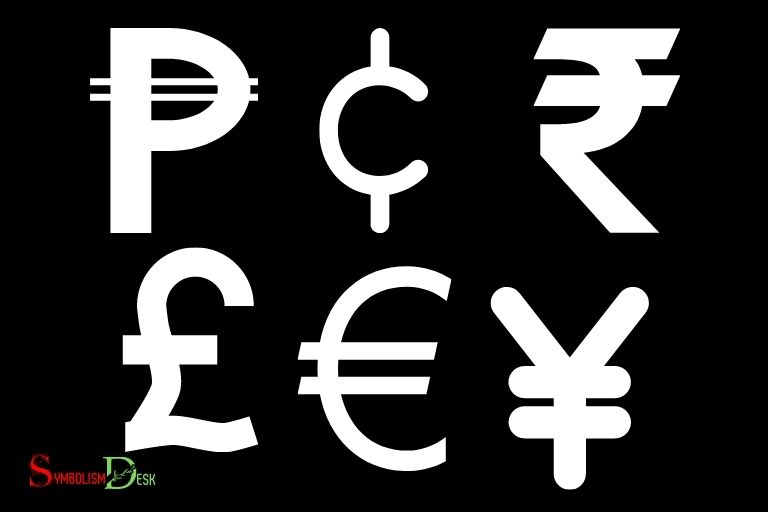Foreign Currency Symbols And Names: Complete List!
Foreign currency symbols and names are used to represent various international currencies, enabling standardized global financial transactions and currency trading.
Currency symbols and names result from the combination of a country’s unique historical, cultural, and economic factors.
They simplify international financial transactions and provide a recognizable identity to currencies, allowing individuals and businesses to efficiently manage their financial dealings globally.
Additionally, they play a significant role in the foreign exchange (forex) market, where currencies are traded against each other.
Understanding foreign currency symbols and names is crucial in today’s globalized economy.
As international trade and investment activities continue to grow, individuals and businesses must be well-versed in these currencies to carry out efficient cross-border transactions.
Consequently, familiarity with these symbols and names is essential for financial professionals, frequent travelers, and global investors alike.
22 Foreign Currency Symbols And Names
| Currency Symbol | Currency Name |
|---|---|
| $ | US Dollar |
| € | Euro |
| ¥ | Japanese Yen |
| £ | British Pound |
| CHF | Swiss Franc |
| C$ | Canadian Dollar |
| A$ | Australian Dollar |
| NZ$ | New Zealand Dollar |
| ₹ | Indian Rupee |
| ₽ | Russian Ruble |
| R | South African Rand |
| RMB | Chinese Yuan |
| ₩ | South Korean Won |
| BRL | Brazilian Real |
| MXN | Mexican Peso |
| SEK | Swedish Krona |
| NOK | Norwegian Krone |
| DKK | Danish Krone |
| SGD | Singapore Dollar |
| HKD | Hong Kong Dollar |
| PLN | Polish Zloty |
| TRY | Turkish Lira |
Key Takeaway

Five Facts About Foreign Currency Symbols And Names
What Are Currency Symbols And Names?
Foreign currency symbols and names are essential to understand when it comes to global trade, international transactions, and traveling. A currency symbol or name is a shorthand used to represent a particular type of currency.
In this section of the blog post, we will define and explain what currency symbols and names are.
Definition Of Currency Symbols
Currency symbols are globally recognized shorthand symbols used to represent a particular currency. These symbols are usually composed of a single letter, three letters or a unique symbol that distinguishes one type of currency from another.
For instance:
- Usd – us dollar
- Eur – euro
- Gbp – british pound
- Jpy – japanese yen
These symbols represent a currency’s purchasing power relative to other currencies in global markets.
Understanding currency symbols is essential for conducting international trade and transactions because it helps to standardize business and streamline the exchange of goods and services between countries.
Definition Of Currency Names
Currency names are the official name of a country’s currency, as recognized by the international community. These names are often included on banknotes, coins, and other financial instruments.
For instance:
- Us dollar – united states
- Euro – european union
- British pound – united kingdom
- Japanese yen – japan
Currency names are used in official documents, business transactions, and other financial dealings.
Understanding currency names is critical when traveling to a foreign country because it helps to identify the local currency and avoid confusion when making purchases.
Understanding currency symbols and names is vital for anyone involved in global trade, international transactions, or traveling.
By knowing these essentials, individuals and businesses can better navigate the complexities of the global economy.
Why Are Currency Symbols And Names Important In Foreign Exchange?
Foreign exchange is a complex world where traders and investors navigate through a variety of international markets striving for profit.
However, in order to succeed in this intricate world, it is essential to understand the language and symbolism that goes with it.
Currency symbols and names are a crucial aspect of foreign exchange and should be taken seriously. Here we delve into why they are so important.
How Currency Symbols And Names Are Used In Financial Transactions
In the world of forex trading, understanding the currency symbols and names is vital. It is impossible to engage with financial transactions without a good understanding of which currency you are dealing with and what is its value.
Here are some examples of usage of currency symbols and names:
Importance Of Knowing Currency Symbols And Names For International Trade
To engage in international trade, it is critical to know the currency used and its exchange rate. The failure to understand this fundamental information can lead to mistakes and costly errors.
Below are some of the reasons why knowing currency symbols and names is essential for international traders:
Currency symbols and names may seem like a trivial matter in the world of foreign exchange, but they are far from it.
A solid understanding of this aspect of forex trading can make a huge difference in performance and profitability.
The Top Foreign Currency Symbols And Names
Foreign currency symbols and names have been in use for centuries. They are essential in international transactions and enable consumers to identify the currency they are using.
The currency symbols and names go hand in hand; the symbol represents the currency’s abbreviated code and is often used on exchange rates charts, while the currency’s name reflects its country of origin.
Brief History Of Foreign Currency Symbols And Names
The history of currency symbols and names can be traced back to the early days of the barter system, where goods and services were exchanged for other goods and services without a standard form of currency.
As societies became more complex, the need for a standardized form of currency grew.
Early coins were stamped to indicate their worth in precious metals, but as economies continued to develop, these markings became more elaborate, adding symbols and letters to represent specific currencies.
Overview Of The Most Widely Used Foreign Currency Symbols And Names
Usd – United States Dollar
The united states dollar (usd) is the most traded currency in the world and is the official currency of the united states of america. The usd is represented by the dollar sign ($), which is a combination of the letters “u” and “s.
Eur – Euro
The euro (eur) is the official currency of the eurozone – a group of 19 european union (eu) member states. The currency is represented by the euro sign (€), which features two horizontal lines across the letter “e. “
Jpy – Japanese Yen
The japanese yen (jpy) is the official currency of japan. The jpy is represented by the yen sign (¥), which features two horizontal lines across two vertical lines.
Gbp – British Pound Sterling
The british pound sterling (gbp) is the official currency of the united kingdom and a few other british territories. The gbp is represented by the pound sign (£), which is a stylized letter “l. “
Chf – Swiss Franc
The swiss franc (chf) is the official currency of switzerland. The chf is represented by the franc sign (fr. ), which is a combination of the letters “ch” for confoederatio helvetica (latin for swiss confederation).
Cad – Canadian Dollar
The canadian dollar (cad) is the official currency of canada. The cad is represented by the dollar sign ($), which is used similarly to the usd.
Aud – Australian Dollar
The australian dollar (aud) is the official currency of australia. The aud is represented by the dollar sign ($), which is also used similarly to the usd.
Nzd – New Zealand Dollar
The new zealand dollar (nzd) is the official currency of new zealand. The nzd is represented by the dollar sign ($), much like the aud and cad. Understanding currency symbols and names is essential for international business.
These symbols and names represent the currencies that are used in countries worldwide, making it easier to conduct transactions. The most widely used foreign currencies are the usd, eur, jpy, gbp, chf, cad, aud, and nzd.
By using these symbols and names, businesses and individuals can quickly and accurately identify the currencies they need to use.
Interesting Facts About Foreign Currency Symbols And Names
Foreign currency symbols and names are fascinating to explore, as they reflect the unique cultures and histories of different countries. For example, the Japanese yen symbol, ¥, is derived from the kanji character 円, which means “circle” or “round.” Meanwhile, the Indian rupee symbol, ₹, is a combination of the Devanagari letter “र” (ra) and the Latin letter “R.” These symbols provide a window into the linguistic and artistic traditions of their respective countries. It is truly intriguing to explore currency symbols worldwide and uncover the stories behind them.
From the intricate designs of the symbols to the meanings behind them, there are many interesting facts to discover.
The Unique Designs And Meanings Behind Currency Symbols
- Currency symbols are not only functional, but also visually appealing, featuring intricate designs and hidden meanings.
- The design of each currency symbol can tell us a lot about the values and culture of the country it represents.
- Some fascinating examples of currency symbols include the japanese yen symbol (¥), which features a stroke through the middle of a circle to represent a coin; and the euro symbol (€), which is based on an ancient greek symbol for the god zeus.
How Currency Symbols And Names Reflect The Cultural Identity Of A Country
- A country’s currency symbol and name can serve as powerful symbols of national pride and identity.
- The choice of a currency symbol and name can reflect a country’s culture, history, and values, as well as its relationship with other countries.
- For example, the indian rupee symbol (₹) features the devanagari script, a nod to india’s unique cultural heritage; while the canadian dollar (cad) symbol depicts a loon, a bird that is native to many canadian lakes.
Fun Facts About Some Foreign Currency Symbols And Names
- Some foreign currency symbols and names have interesting stories and origins that are worth exploring.
- Did you know that the icelandic krona symbol (kr) is based on an ancient viking unit of weight, known as the “mark”; or that the chinese yuan symbol (¥) is derived from the mandarin word for “round coin”?
- Other fun facts include the fact that the polish zloty symbol (zł) features a slash through its middle, to separate it visually from the similar-looking letter l; and that the swedish krona symbol (kr) is designed to resemble an ancient viking sword.
Overall, foreign currency symbols and names offer a glimpse into the rich and diverse cultures of our world.
By exploring these symbols and their meanings, we can gain a deeper appreciation for the history and traditions of different countries, and the role that currency plays in shaping their national identities.
Are Marvel Characters’ Symbols and Names Similar to Foreign Currency Symbols and Names?
Marvel characters symbols and names are often distinct and unique, much like foreign currency symbols and names. Just as currencies have their own representations, superheroes like Captain America and Iron Man possess recognizable symbols. These symbols become synonymous with their characters, just as foreign currencies are tied to specific countries. The resemblance between Marvel character symbols and foreign currency symbols lies in their symbolic representation and the lasting impact they have on pop culture.
FAQ Of Foreign Currency Symbols And Names
What Are The Most Common Foreign Currency Symbols?
The most commonly used foreign currency symbols are usd, eur, gbp, jpy, and cad.
What Are The Most Widely Used Currency Names?
The most widely used currency names are the us dollar, euro, british pound, japanese yen, and swiss franc.
Why Do Currencies Have Symbols?
Currencies have symbols to represent them visually and make them easily recognizable in financial transactions.
How Do I Type Foreign Currency Symbols On My Keyboard?
You can type foreign currency symbols on your keyboard by using the alt code or by copying and pasting them from a website or document.
What Are Some Common Misconceptions About Foreign Currency Symbols?
Some common misconceptions about foreign currency symbols include that they are the same as currency abbreviations, and that each country only has one currency symbol.
Conclusion
As you can see, understanding foreign currency symbols and names is crucial in today’s global economy.
The world is connected like never before, and with businesses conducting transactions across borders, having a grasp on the different currencies is an asset.
It allows for smoother financial exchanges and helps businesses avoid any costly errors. Not only that, but being able to decode currency symbols will also assist travellers in conducting their purchases with ease in foreign countries.
Taking the time to research and become knowledgeable about foreign currency symbols and names will not only benefit businesses but individuals as well.
It will be worth your investment of time and energy, and will ultimately help you navigate the global marketplace with more confidence and ease.






